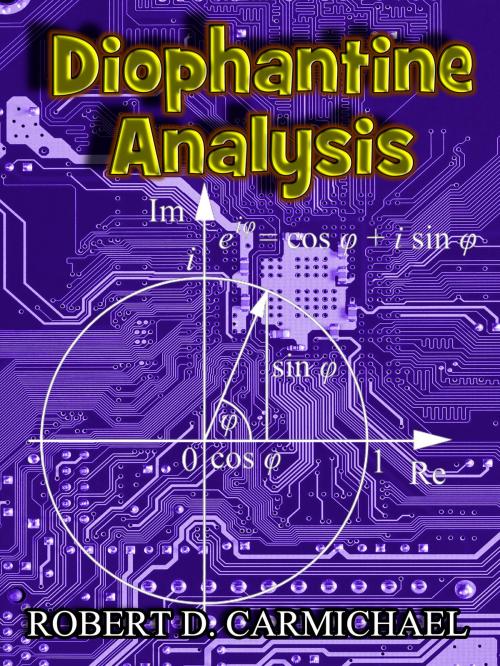Diophantine Analysis - (Discrete Mathematics)
Nonfiction, Science & Nature, Mathematics, Differential Equations, Discrete Mathematics, Science, Physics, Mathematical Physics| Author: | Robert Carmichael | ISBN: | 1230000143373 |
| Publisher: | Carmichael | Publication: | June 20, 2013 |
| Imprint: | Language: | English |
| Author: | Robert Carmichael |
| ISBN: | 1230000143373 |
| Publisher: | Carmichael |
| Publication: | June 20, 2013 |
| Imprint: | |
| Language: | English |
Diophantine Analysis
The purpose in writing this book has been to supply the reader with a convenient introduction to Diophantine Analysis. The choice of material has been determined by the end in view. No attempt has been made to include all special results, but a large number of them are to be found both in the text and in the exercises. The general theory of quadratic forms has been omitted entirely, since that subject would require a volume in itself. The reader will therefore miss such an elegant theorem as the following: Every positive integer may be represented as the sum of four squares. Some methods of frequent use in the theory of quadratic forms, in particular that of continued fractions, have been left out of consideration even though they have some value for other Diophantine questions. This is done for the sake of unity and brevity. Probably these omissions will not be regretted, since there are accessible sources through which one can make acquaintance with the parts of the theory excluded.
Concerning the exercises, they are intended to serve three purposes: to afford practice material for developing facility in the handling of problems in Diophantine analysis; to give an indication of what special results have already been obtained and what special problems have been found amenable to attack; and to point out unsolved problems which are interesting either from their elegance or from their relation to other problems which already have been treated.
Corresponding roughly to these three purposes the problems have been divided into three classes. Those which have no distinguishing mark are intended to serve mainly the purpose first mentioned. Of these there are 133, of which 45 are in the Miscellaneous Exercises at the end of the book. Many of them are inserted at the end of individual sections with the purpose of suggesting that a problem in such position is readily amenable to the methods employed in the section to which it is attached.
Finally those exercises which are marked with a dagger (35 in number) are intended to suggest investigations which have not yet been carried out so far as the author is aware. Some of these are scarcely more than exercises, while others call for investigations of considerable extent or interest.
Robert D. Carmichael.
CONTENTS:
I INTRODUCTION RATIONAL TRIANGLES METHOD OF INFINITE DESCENT
§ 1 Introductory Remarks
§ 2 Remarks Relating to Rational Triangles
§ 3 Pythagorean Triangles
§ 4 Rational Triangle
§ 5 Impossibility of the System x2 + y2 = z2, y2 + z2 = t2
§ 6 The Method of Infinite Descent
II PROBLEMS INVOLVING A MULTIPLICATIVE DOMAIN
§ 7 On Numbers of the Form x2 + axy + by2
§ 8 On the Equation x2 − Dy2 = z2
§ 9 General Equation of the Second Degree in Two Variables
§ 10 Quadratic Equations Involving More than Three Variables
§ 11 Certain Equations of Higher Degree
§ 12 On the Extension of a Set of Numbers so as to Form a Multiplicative Domain
III EQUATIONS OF THE THIRD DEGREE
§ 13 On the Equation kx3 + ax2y + bxy2 + cy3 = t2
§ 14 On the Equation kx3 + ax2y + bxy2 + cy3 = t3
§ 15 On the Equation x3 + y3 + z3 − 3xyz = u3 + v3 + w3 − 3uvw
§ 16 Impossibility of the Equation x3 + y3 = 2mz3
IV EQUATIONS OF THE FOURTH DEGREE
§ 17 On the Equation ax4 + bx3y + cx2y2 + dxy3 + ey4 = mz2
§ 18 On the Equation ax4 + by4 = cz2
§ 19 Other Equations of the Fourth Degree
V EQUATIONS OF DEGREE HIGHER THAN THE FOURTH THE FERMAT PROBLEM
§ 20 Remarks Concerning Equations of Higher Degree
§ 21 Elementary Properties of the Equation xn + yn = zn,n > 2
§ 22 Present State of Knowledge Concerning the Equation xp + yp + zp = 0
VI THE METHOD OF FUNCTIONAL EQUATIONS
§ 23 Introduction Rational Solutions of a Certain Functional Equation
§ 24 Solution of a Certain Problem from Diophantus
§ 25 Solution of a Certain Problem Due to Fermat
Diophantine Analysis
The purpose in writing this book has been to supply the reader with a convenient introduction to Diophantine Analysis. The choice of material has been determined by the end in view. No attempt has been made to include all special results, but a large number of them are to be found both in the text and in the exercises. The general theory of quadratic forms has been omitted entirely, since that subject would require a volume in itself. The reader will therefore miss such an elegant theorem as the following: Every positive integer may be represented as the sum of four squares. Some methods of frequent use in the theory of quadratic forms, in particular that of continued fractions, have been left out of consideration even though they have some value for other Diophantine questions. This is done for the sake of unity and brevity. Probably these omissions will not be regretted, since there are accessible sources through which one can make acquaintance with the parts of the theory excluded.
Concerning the exercises, they are intended to serve three purposes: to afford practice material for developing facility in the handling of problems in Diophantine analysis; to give an indication of what special results have already been obtained and what special problems have been found amenable to attack; and to point out unsolved problems which are interesting either from their elegance or from their relation to other problems which already have been treated.
Corresponding roughly to these three purposes the problems have been divided into three classes. Those which have no distinguishing mark are intended to serve mainly the purpose first mentioned. Of these there are 133, of which 45 are in the Miscellaneous Exercises at the end of the book. Many of them are inserted at the end of individual sections with the purpose of suggesting that a problem in such position is readily amenable to the methods employed in the section to which it is attached.
Finally those exercises which are marked with a dagger (35 in number) are intended to suggest investigations which have not yet been carried out so far as the author is aware. Some of these are scarcely more than exercises, while others call for investigations of considerable extent or interest.
Robert D. Carmichael.
CONTENTS:
I INTRODUCTION RATIONAL TRIANGLES METHOD OF INFINITE DESCENT
§ 1 Introductory Remarks
§ 2 Remarks Relating to Rational Triangles
§ 3 Pythagorean Triangles
§ 4 Rational Triangle
§ 5 Impossibility of the System x2 + y2 = z2, y2 + z2 = t2
§ 6 The Method of Infinite Descent
II PROBLEMS INVOLVING A MULTIPLICATIVE DOMAIN
§ 7 On Numbers of the Form x2 + axy + by2
§ 8 On the Equation x2 − Dy2 = z2
§ 9 General Equation of the Second Degree in Two Variables
§ 10 Quadratic Equations Involving More than Three Variables
§ 11 Certain Equations of Higher Degree
§ 12 On the Extension of a Set of Numbers so as to Form a Multiplicative Domain
III EQUATIONS OF THE THIRD DEGREE
§ 13 On the Equation kx3 + ax2y + bxy2 + cy3 = t2
§ 14 On the Equation kx3 + ax2y + bxy2 + cy3 = t3
§ 15 On the Equation x3 + y3 + z3 − 3xyz = u3 + v3 + w3 − 3uvw
§ 16 Impossibility of the Equation x3 + y3 = 2mz3
IV EQUATIONS OF THE FOURTH DEGREE
§ 17 On the Equation ax4 + bx3y + cx2y2 + dxy3 + ey4 = mz2
§ 18 On the Equation ax4 + by4 = cz2
§ 19 Other Equations of the Fourth Degree
V EQUATIONS OF DEGREE HIGHER THAN THE FOURTH THE FERMAT PROBLEM
§ 20 Remarks Concerning Equations of Higher Degree
§ 21 Elementary Properties of the Equation xn + yn = zn,n > 2
§ 22 Present State of Knowledge Concerning the Equation xp + yp + zp = 0
VI THE METHOD OF FUNCTIONAL EQUATIONS
§ 23 Introduction Rational Solutions of a Certain Functional Equation
§ 24 Solution of a Certain Problem from Diophantus
§ 25 Solution of a Certain Problem Due to Fermat















